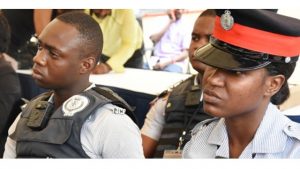
Jamaica Constabulary Force members wear body cameras as part of a pilot project launched in August at the Office of the Commissioner of Police on Old Hope Road in St Andrew.
THE long-touted move to outfit police officers with body cameras is finally a reality.
The Jamaica Constabulary Force (JCF) announced yesterday that police officers in Kingston and St Andrew have started using body cameras, albeit more than two years after it was first announced, and only in four police divisions.
In a news release from the Corporate Communications Unit, the JCF said the move is in keeping with the organisation’s thrust to enhance professionalism.
At a post-Cabinet press briefing in 2014, then Security Minister Peter Bunting announced that cops would be wearing body cameras before the end of the year. Bunting’s disclosure was made amid renewed concerns over allegations of extrajudicial killings and misconduct by members of the force.
The body cameras were expected to add another layer of accountability in the JCF.
Last year January, former Police Commissioner Dr Carl Williams announced that police officers would start wearing the recording devices between the first and second quarter of the year. Then in August, 120 body cameras were presented to the JCF from the United States Government as part of a pilot project.
The then commissioner had said six JCF divisions — St Andrew Central, St Andrew South, Kingston East, Kingston Central, Motorised Patrol, and Traffic headquarters — would receive 20 cameras each and the data submitted to the Information Communications Technology division for processing at the end of each duty. He had said, too, that the programme would eventually be expanded.
Several months after the body cameras were presented to the JCF, they are now being worn by cops in Kingston eastern, Kingston Central, St Andrew Central, and Kingston Western divisions.
Last year, Williams had explained that the data would be logged in a fingerprint-protected room, where only officers equipped with the devices and other relevant authorities can enter. He had also said that that data would be stored for a maximum of three months.
The overall project, which included the devices, installation, and training for use, cost the US Government US$400,000.
